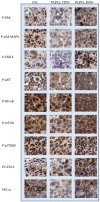Tissue-microarray based immunohistochemical analysis of survival pathways in nodular sclerosing classical Hodgkin lymphoma as compared with Non-Hodgkin's lymphoma
- PMID: 20369041
- PMCID: PMC2848307
Tissue-microarray based immunohistochemical analysis of survival pathways in nodular sclerosing classical Hodgkin lymphoma as compared with Non-Hodgkin's lymphoma
Abstract
Neoplastic cells rely on key oncogenic pathways for their gain of proliferative and/or loss of apoptotic potential. Therapy targeted at specific points in these pathways has the potential to eliminate cancer cells by inducing differentiation or apoptosis. Concurrent immunophenotypic evaluation of survival pathways in nodular sclerosing classical Hodgkin lymphoma (cHL-NS) tissues has not previously been undertaken. We took the tissue microarray (TMA)-based approach to retrospectively evaluate the activation state of key oncogenic pathways by immunohisto-chemistry (IHC) in a series of 6 cases of cHL-NS (with predominantly syncitial areas). For comparison, 2 cases of diffuse large B-cell lymphoma (DLBCL), and 1 case of follicular hyperplasia (FH) were included in the study. Infiltration of T regulatory cells (Tregs) in the tumor microenvironment was assessed by expression of the Foxp3 transcription factor. Differential upregulation of the mitogen-activated protein kinase (MAPK)-extracellular signal related kinase (ERK), signal transducers and activators of transcription (STAT)3, and protein kinase c - alpha (PKC-alpha) pathways was seen among the cHL cases, whereas nuclear factor - kappa B (NF-kB) and phosphoinositide 3 kinase (PI3 K)-AKT-mammalian target of rapamycin (mTOR) pathways were equally activated in the neoplastic Reed-Sternberg cells of the 6 cHL-NS cases. Marked difference in the morphoproteomic profile was seen amongst the two cases of DLBCL. The amount of Foxp3+ T regulatory cells (Tregs) in the tumor microenvironment was highly variable ranging from 6/hpf to 120/hpf in cHL-NS, and 1/hpf to 82/hpf in DLBCL. In this pilot study, concurrent evaluation of oncogenic pathways in cHL-NS and DLBCL offers powerful insights in the putative therapeutic targets for an individualized approach to diagnosis and therapy.
Keywords: Classical Hodgkin lymphoma; diffuse large B-cell lymphoma; morphoproteomics; survival pathways; tissue microarray.
Figures






References
-
- Diehl V, Thomas RK, Re D. Part II: Hodgkin's lymphoma-diagnosis and treatment. Lancet Oncol. 2004;5:19–26. - PubMed
-
- Dancey J, Sausville EA. Issues and progress with protein kinase inhibitors for cancer treatment. Nat Rev Drug Discov. 2003;2:296–313. - PubMed
-
- Hinz M, Loser P, Mathas S, Krappmann D, Dorken B, Scheidereit C. Constitutive NF-kappaB maintains high expression of a characteristic gene network, including CD40, CD86, and a set of antiapoptotic genes in Hodgkin/Reed-Sternberg cells. Blood. 2001;97:2798–2807. - PubMed
-
- Brown RE, Kamal NR. p-p70S6K (Thr 389) Expression in nodular sclerosing hodgkin's disease as evidence for receptor tyrosine kinase signaling. Ann Clin Lab Sci. 2005;35:413–414. - PubMed
-
- Kube D, Holtick U, Vockerodt M, Ahmadi T, Haier B, Behrmann I, Heinrich PC, Diehl V, Tesch H. STAT3 is constitutively activated in Hodgkin cell lines. Blood. 2001;98:762–770. - PubMed
LinkOut - more resources
Full Text Sources
Other Literature Sources
Miscellaneous
